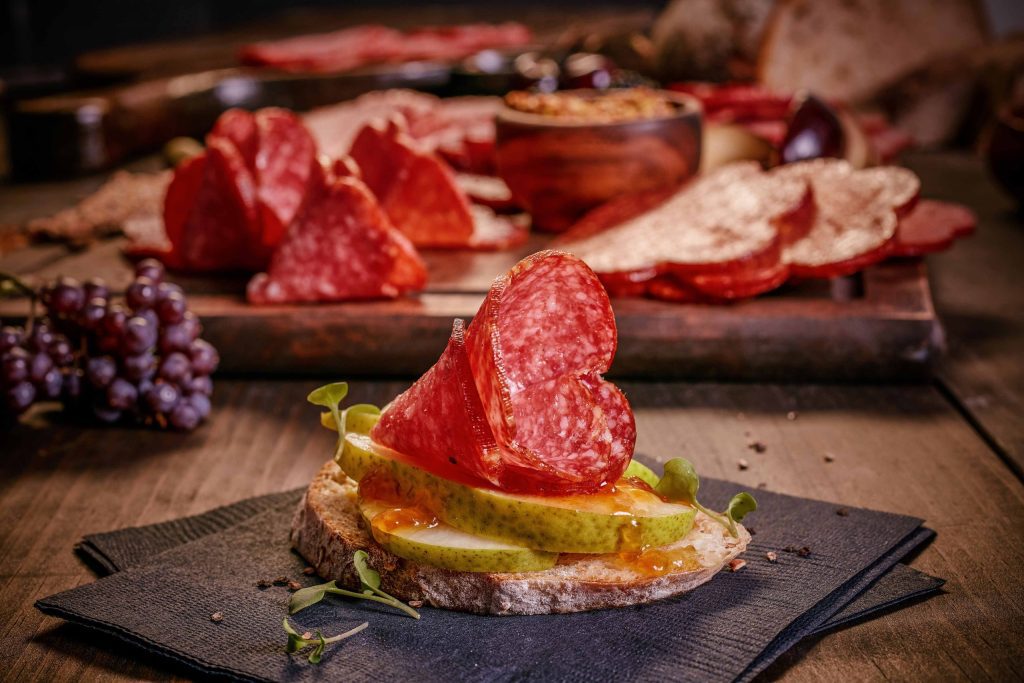Spotlighting Salami Made in the USA
April 2, 2019 | 6 min to read
Salting, fermenting, and air-drying have preserved food since ancient Roman times, giving rise to salami, which spread through Europe and arrived in America in the early 20th century. The 1970s and 1980s saw mass production diminish its quality, but a recent artisan revival emphasizes unique flavors and traditional methods. Today, salami ranks as the fifth most popular deli meat in America. Producers focus on quality, clean ingredients, and creating engaging charcuterie experiences to drive sales.

Salting, fermenting and air-drying are among mankind’s oldest food preservation techniques. In Roman times, pork prepared in this way was part of a group of foods called ‘salsum’ or salted. It’s from this ancient term that we get the word ‘salami.’
Fast forward through the ages and salami making spreads throughout Europe. Germany, Hungary, France, Spain and especially Italy are known for its salamis.
Salami making crossed the pond to America in the early 20th century, when Italian immigrants brought this culinary craft with them.
Then, the country fell into what some producers call the ‘scary days’ of the 1970’s and 1980’s. This is when much of the deli salami in mainstream supermarkets was mass produced to suit less adventurous American palates and, thus, lost a chunk of its rich storyline.
Today, and over the past five to 10 years, a renaissance has been happening. That is, some U.S. and Canadian producers haven taken grandfather’s old country recipe and used carefully curated ingredients and curing methods to produce artisan salami products with both traditional and trendy flavors.
It’s no wonder that, in 2017, salami ranked as the fifth most popular American deli meat, after turkey, ham, beef and chicken, according to What’s In Store 2019, published by the Madison, WI-headquartered International Dairy Deli Bakery Association (IDDBA).
Following are tips to capitalize on this popular deli favorite.
1. Sell The Artisan Flavor
Taste experience is driving the growth of artisanal salamis, says David Brandow, director of international sales for Piller’s Fine Foods, makers of Black Kassel brand meats, based in Waterloo, Ontario, Canada. “The time-honored traditions in producing these authentic products allow for the complex flavors to develop and mature and provides a taste experience much like consumers’ experience with fine wines, craft beers and fine cheeses. These unique taste experiences cannot be achieved in cooked products that are produced in a day.”
Shoppers are also looking for unique flavors. For example, Tempesta Artisan Salumi, co-founded in 2014 in Chicago by fifth generation father and son Italian salumi makers, Agostino and Antonio Fiasche, first introduced Nduja. This spreadable salami spiked with Calabrian peppers cannot be imported into the United States from Italy. Beyond this, the duo’s first experimentation outside of customarily seasoned salami was their ‘Nostrano,’ meaning ‘our own,’ Pink Peppercorn Salame, which offers a slight sweetness. More recently, the company developed its Salami di Manzo, made from 100 percent American Wagyu beef seasoned with black pepper, thyme and Cabernet wine, for customers who don’t eat pork.
“Quality and taste are most important,” says Matt Reilly, Tempesta’s national sales director. “Just because a salami is imported doesn’t automatically make it better than one produced in the United States.”
Clean-labeled and better-for-you salami products, such as those made from heritage breed pigs raised without antibiotics and fed a 100 percent vegetarian diet as well as those labeled natural, gluten-free and with no nitrates or nitrites added, are key to artisan production for U.S. producers.
“We have remained an industry leader in terms of removing synthetic nitrates and nitrites from our products,” says Deanna Depke, marketing manager and fourth generation of family-owned Volpi Foods, in St. Louis.
2. Create An Entertaining Destination
Salami is mostly consumed as the centerpiece of a charcuterie platter, says Al Adelson, vice president of sales for Veroni USA, Inc., a Swedesboro, NJ-based slicer and repacker of Italian-made salami. “It’s possible to create great in-store theater with charcuterie, however supermarket deli operators need to figure out how to tell the story and romance the products. More specifically, because of the high cost per pound, operators need to show that a little salami goes a long way, that customers shouldn’t think about the $24 per pound price because one-quarter pound is only $6 and that can be a lot of great tasting salami. Restaurants charge a lot for charcuterie, so consumers can enjoy, for a fraction of restaurant prices, creating their own platters at home.”
A great way to do this is through attention-getting displays.
“Marketplaces are using their artisan salami sets to help transform the overall appearance in their deli and specialty cheese sections to create a one-stop solution for entertaining the taste buds for any occasion,” says Evan Inada, customer marketing manager for Columbus Craft Meats, a Hayward, CA-based brand of the Hormel Foods Corp., headquartered in Austin, MN. “Merchandise great pairings, such as olives, crackers and breads, alongside the artisan salami to drive sales for customers looking to have a culinary experience with their salami.”
Piller’s Fine Foods sells its Black Kassel brand salami in eye-catching shapes, such as flowers, hearts, squares and diamonds. These can make deli-made chartcuterie boards, or those customers make at home, Instagram worthy.
“We also provide a detailed flavor profile of each of our salamis and a pairing guide of complementary food and beverages,” says Piller’s Fine Foods’ Brandow.

3. Promote As A Grab-And-Go Snack
Snacking, and in particular meat snacks, has had tremendous growth since 2012, according to Brandow. “Consumers today are seeking a good source of on-the-go protein. Data shows meat snacks skew younger, with 60 percent being consumed by 18- to 34-year-olds. We have launched our traditional salamis in meat-snack formats that have been received very well. However, meat sticks and options that provide a softer, easier-to-chew texture may open up consumption across other demographics.”
To this point, Volpi Foods offers its Roltini Singles, which includes spicy salami wrapped around a Mozzarella cheese stick. These snacks are packaged 1.5-ounces each and are sold 12 to a pack.
This spring, Principe Foods Inc., USA, in Long Beach, CA, will introduce a six-item line of pre-sliced antibiotic-free snack salami in 3-ounce packs. Four of these are imported — Genoa, fennel salami, soppressata and hot soppressata, and two are made in the United States — pepperoni and chorizo. All are sliced in the United States for a longer shelf life.
“The pre-sliced business, especially the snack segment, is growing, and I think you’ll see products such as these transform the wall deli in years to come,” says Alberto Minardi, Principe’s chief executive. “These products can also be merchandised in the cheese case, in the dairy case or in the meat department.”
4. Open Shoppers’ Eyes To All The Possibilities
Salami isn’t just for charcuterie platters and snacking. There’s a full menu of other usages that can lend to creative merchandising in both the supermarket’s deli and prepared foods department.
“Salumi is being used as a sexy ingredient to complement salads and roasted meats because of the umami that slow-cured meats add to any dish,” says Columbus Craft Meats’ Inada.
Artisan sandwiches, paninis, pasta dishes, unique pizza toppings and even garnishes for craft cocktails are innovative ways chefs are using salami today, notes Volpi Foods’ Depke.
Out-of-the-box usages, such as a Scotch egg wrapped in Nduja rather than sausage before being breaded and deep-fried and Nduja spread on fresh Mozzarella and rolled up pinwheel style, are gaining traction. “These are a few of the things my chefs came up with when I let them play with the product,” says Tempesta’s Reilly, a Culinary Institute of America-trained chef who managed the Salumi and Formaggi cases at Eataly locations in New York City and Boston. “When your staff plays with and understands a product, they are better equipped to educate customers and sell it.”

5. Take Advantage Of Seasonality
Much like the way consumers covet special vintages of wines and spirits at specific times of the year, this is now spilling over into food products, according to Piller’s Fine Foods’ Brandow. “We launched special ‘Winter Salami,’ which lends itself perfectly to social gatherings and celebration.”This product has a history that dates to the 13th century, when sausage from hogs harvested in the fall was lightly smoked over select hardwoods, along with spices like nutmeg and white pepper, to provide a product with an initial subtle pepper flavor finished by nutty overtones. It was a luxury food in the cold of winter for European villagers. This dry-aged premium salami, produced in the same way and packaged in an 8-ounce chub, comes in a wood veneer box with a gift tag. DB
1 of 7 article in DeliBusiness Apr/May 2019

